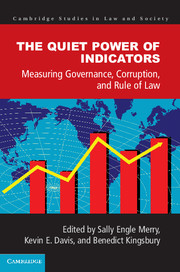Book contents
- Frontmatter
- Contents
- Notes on Contributors
- Acknowledgments
- Introduction: The Local-Global Life of Indicators: Law, Power, and Resistance
- PART I GLOBAL INDICATORS OF GOVERNANCE, CORRUPTION, AND RULE OF LAW
- 1 International Organizations and the Production of Indicators: The Case of Freedom House
- 2 Indicators and the Law: A Case Study of the Rule of Law Index
- 3 Measuring Corporate Accountability through Global Indicators
- 4 The Quest for Measuring Development: The Role of the Indicator Bank
- 5 Tradeoffs in Accountability: Conditionality Processes in the European Union and Millennium Challenge Corporation
- Part II INDICATORS IN LOCAL CONTEXTS
- Index
- Books in the Series
- References
4 - The Quest for Measuring Development: The Role of the Indicator Bank
from PART I - GLOBAL INDICATORS OF GOVERNANCE, CORRUPTION, AND RULE OF LAW
Published online by Cambridge University Press: 05 June 2015
- Frontmatter
- Contents
- Notes on Contributors
- Acknowledgments
- Introduction: The Local-Global Life of Indicators: Law, Power, and Resistance
- PART I GLOBAL INDICATORS OF GOVERNANCE, CORRUPTION, AND RULE OF LAW
- 1 International Organizations and the Production of Indicators: The Case of Freedom House
- 2 Indicators and the Law: A Case Study of the Rule of Law Index
- 3 Measuring Corporate Accountability through Global Indicators
- 4 The Quest for Measuring Development: The Role of the Indicator Bank
- 5 Tradeoffs in Accountability: Conditionality Processes in the European Union and Millennium Challenge Corporation
- Part II INDICATORS IN LOCAL CONTEXTS
- Index
- Books in the Series
- References
Summary
INTRODUCTION
Development indicators constitute a technology of global governance because of their knowledge and their governance effects. The knowledge effect is determined by the underlying development theory that is promoted by both indicator users and generators, which may be articulated through an economic, an institutional, or a rights-based frame of reference. The increased use of expert knowledge in the development field has encouraged the use of indicators as a proxy for development not only by hegemonic institutions, such as the World Bank, but also by other indicator users or generators that seek to contest the development “commonsense.” The World Bank remains one of the most important producers and users of indicators, and through its World Development Indicators (WDI) it has managed to promote hegemonic theories of development based on economics-based frames of reference. Although the World Bank has expanded its development discourse to include concerns of institutions and rights-based approaches, it has continuously relied on economic indicators as the main tool to measure development.
Once the knowledge that is being promoted by the development indicator is established, it becomes easier to unveil the production of standards and identities that are being shaped in the development field as a result of the use of a specific indicator. The development knowledge disseminated by the indicator in turn shapes the outcome of its governance effect. As described in the third section, indicators can have a wide range of effects on global governance; however, the most common ones for the development field are the regulatory effect and the allocation of responsibilities. The regulatory effect should be understood as a type of governance at a distance, as “indicator users” can influence the performance of “indicator targets” by sending signals of the kind of society that is expected from developed societies, This effect increases when performance indicators are used to allocate aid based on the economic incentive.
- Type
- Chapter
- Information
- The Quiet Power of IndicatorsMeasuring Governance, Corruption, and Rule of Law, pp. 133 - 155Publisher: Cambridge University PressPrint publication year: 2015
References
- 6
- Cited by

